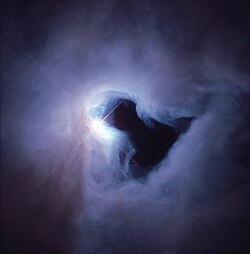One of the most massive stars known is Eta Carinae,[91] with 100–150 times as much mass as the Sun; its lifespan is very short—only several million years at most. A recent study of the Arches cluster suggests that 150 solar masses is the upper limit for stars in the current era of the universe.[92] The reason for this limit is not precisely known, but it is partially due to the Eddington luminosity which defines the maximum amount of luminosity that can pass through the atmosphere of a star without ejecting the gases into space.

The first stars to form after the Big Bang may have been larger, up to 300 solar masses or more,[93] due to the complete absence of elements heavier than lithium in their composition. This generation of supermassive, population III stars is long extinct, however, and currently only theoretical.
With a mass only 93 times that of Jupiter, AB Doradus C, a companion to AB Doradus A, is the smallest known star undergoing nuclear fusion in its core.[94] For stars with similar metallicity to the Sun, the theoretical minimum mass the star can have, and still undergo fusion at the core, is estimated to be about 75 times the mass of Jupiter.[95][96] When the metallicity is very low, however, a recent study of the faintest stars found that the minimum star size seems to be about 8.3% of the solar mass, or about 87 times the mass of Jupiter.[96][97] Smaller bodies are called brown dwarfs, which occupy a poorly defined grey area between stars and gas giants.
The combination of the radius and the mass of a star determines the surface gravity. Giant stars have a much lower surface gravity than main sequence stars, while the opposite is the case for degenerate, compact stars such as white dwarfs. The surface gravity can influence the appearance of a star's spectrum, with higher gravity causing a broadening of the absorption lines


0 comments:
Post a Comment